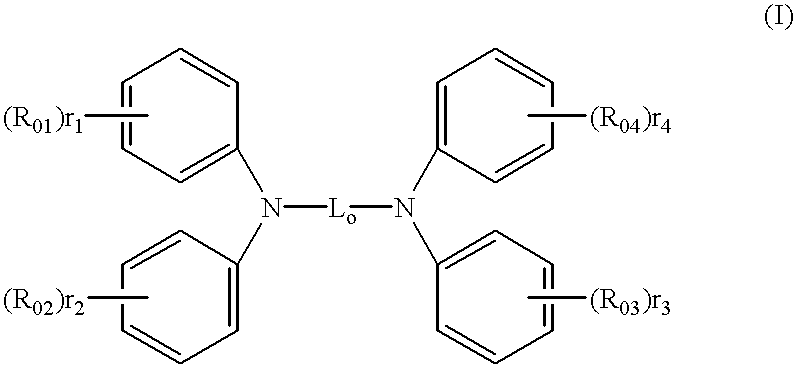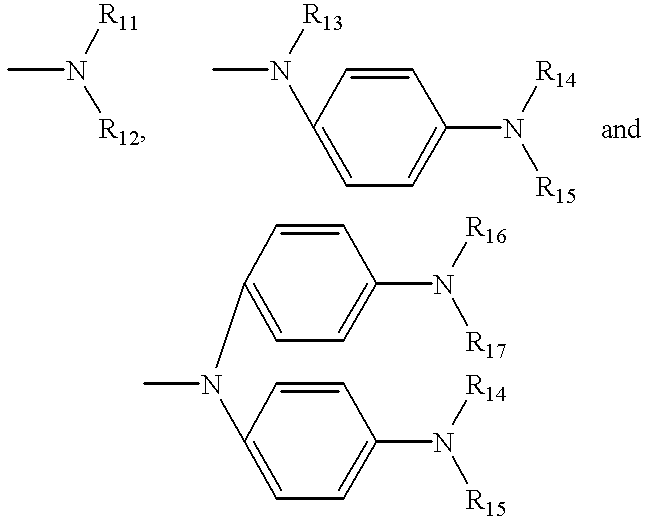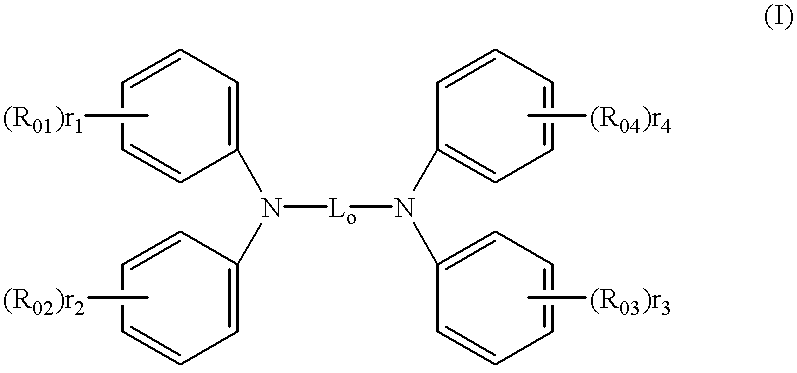Organic electroluminescent elements
a technology of electroluminescent elements and organic materials, applied in the direction of discharge tubes/lamp details, discharge tubes luminescnet screens, other domestic articles, etc., can solve the problems of short light emission life, low storage robustness and reliability, low light emission efficiency, current leakage, etc., to improve hole mobility, optimize hole injection efficiency, and improve the effect of thin film property
- Summary
- Abstract
- Description
- Claims
- Application Information
AI Technical Summary
Benefits of technology
Problems solved by technology
Method used
Image
Examples
synthesis example 1
Synthesis of N,N'-diphenyl-N,N'-bis[N-phenyl-N-3-tolyl(4-aminophenyl)]benzidine (HIM33: compound No. 3)
In a 200 ml reaction vessel 26 grams of N,N-diphenyl-1,4-phenylenediamine and 22 grams of 3-iodotoluene were heated together with 0.3 grams of activated copper powders, 50 grams of potassium carbonate and 50 ml of decalin at an oil bath temperature of 200.degree. C. for 24 hours in an Ar atmosphere. After the completion of the reaction, the reaction solution was filtrated with the addition of 100 ml of toluene thereto, thereby removing insolubles. The filtrate was washed with water, and dried over sodium sulfate. Following this, the solvent was removed by distillation from the filtrate, and the residue was purified twice by means of a silica gel column (using a mixed solvent of n-hexane and toluene as a developing solvent), thereby obtaining 17 grams of N,N'-diphenyl-N-(3-tolyl)-1,4-phenylenediamine.
Then, in a 200 ml reaction vessel 10 grams of N,N'-diphenyl-N-(3-tolyl)-1,4-phenyle...
synthesis example 2
Synthesis of N,N'-diphenyl-N,N'-bis[N-phenyl-N-4-tolyl(4-aminophenyl)]benzidine (HIM34: compound No. 2)
N,N'-diphenyl-N,N'-bis[N-phenyl-N-4-tolyl(4-aminophenyl)]benzidine referred to below as HIM34 was obtained as in synthesis example 1 with the exception that 4-iodotoluene was used in place of 3-iodotoluene. ##STR957##
Mass spectrometry: m / e 850(M.sup.+)
.sup.1 H-NMR spectra are shown in FIG. 5.
.sup.13 C-NMR spectra are shown in FIG. 6.
Infrared absorption spectra are shown in FIG. 7.
Differential scanning calorimetry (DSC)
Melting point: unmeasurable because of amorphism
Glass transition temperature (DSC): 107.degree. C.
synthesis example 3
Synthesis of N,N'-diphenyl-N,N'-bis[N-phenyl-N-4-tolyl(4-aminophenyl)]benzidine (HIM38: compound No. 16)
N,N'-diphenyl-N,N'-bis[N-phenyl-N-4-tolyl(4-aminophenyl)]benzidine referred to below as HIM38 was obtained as in synthesis example 1 with the exception that 4-iodonaphthalene was used in place of 3-iodotoluene. ##STR958##
Mass spectrometry: m / e 922(M.sup.+)
.sup.1 H-NMR spectra are shown in FIG. 8.
.sup.13 C-NMR spectra are shown in FIG. 9.
Infrared absorption spectra are shown in FIG. 10.
Differential scanning calorimetry (DSC)
Melting point: unmeasurable because of amorphism
Glass transition temperature (DSC): 125.degree. C.
PUM
| Property | Measurement | Unit |
|---|---|---|
| thickness | aaaaa | aaaaa |
| light emission maximum wavelength | aaaaa | aaaaa |
| thickness | aaaaa | aaaaa |
Abstract
Description
Claims
Application Information
 Login to View More
Login to View More - R&D
- Intellectual Property
- Life Sciences
- Materials
- Tech Scout
- Unparalleled Data Quality
- Higher Quality Content
- 60% Fewer Hallucinations
Browse by: Latest US Patents, China's latest patents, Technical Efficacy Thesaurus, Application Domain, Technology Topic, Popular Technical Reports.
© 2025 PatSnap. All rights reserved.Legal|Privacy policy|Modern Slavery Act Transparency Statement|Sitemap|About US| Contact US: help@patsnap.com



